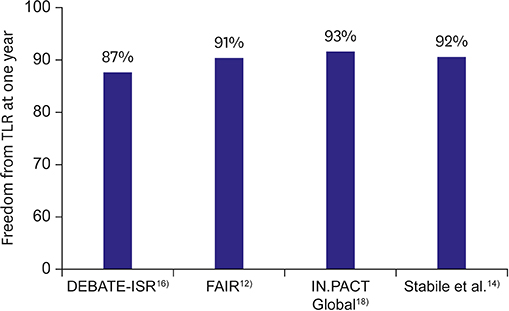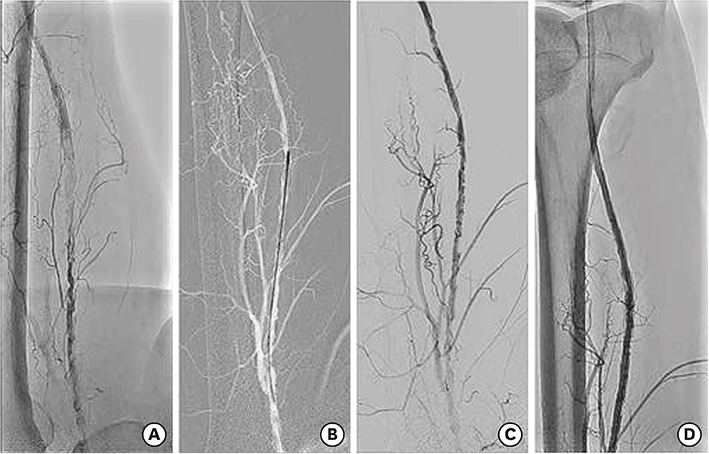Korean Circ J.
2018 Mar;48(3):191-197. 10.4070/kcj.2018.0074.
Treatment of Femoropopliteal Artery In-stent Restenosis
- Affiliations
-
- 1Division of Cardiology, Eulji University Hospital, Eulji University School of Medicine, Daejeon, Korea.
- 2Division of Cardiology, Department of Internal Medicine, Severance Cardiovascular Hospital, Yonsei University College of Medicine, Seoul, Korea. cdhlyj@yuhs.ac
- KMID: 2406922
- DOI: http://doi.org/10.4070/kcj.2018.0074
Abstract
- Femoropopliteal (FP) artery-in stent restenosis (ISR) is a daunting management problem that we continue to face. FP artery-ISR rates after primary stent implantation are relatively high. Although repeat FP artery-ISR and the need for additional interventions remain all too common, little consensus exists regarding the best treatment algorithm. In this article, we review the limitations of the currently used devices for the endovascular treatment of FP artery-ISR and discuss which strategies are the most effective and safe.
Keyword
Figure
Reference
-
1. Shammas NW. An overview of optimal endovascular strategy in treating the femoropopliteal artery: mechanical, biological, and procedural factors. Int J Angiol. 2013; 22:1–8.
Article2. Tosaka A, Soga Y, Iida O, et al. Classification and clinical impact of restenosis after femoropopliteal stenting. J Am Coll Cardiol. 2012; 59:16–23.
Article3. Ko YG, Ahn CM, Min PK, et al. Baseline characteristics of a retrospective patient cohort in the Korean Vascular Intervention Society Endovascular Therapy in Lower Limb Artery Diseases (K-VIS ELLA) Registry. Korean Circ J. 2017; 47:469–476.
Article4. Hoffmann R, Mintz GS, Dussaillant GR, et al. Patterns and mechanisms of in-stent restenosis. A serial intravascular ultrasound study. Circulation. 1996; 94:1247–1254.5. Mehran R, Dangas G, Abizaid AS, et al. Angiographic patterns of in-stent restenosis: classification and implications for long-term outcome. Circulation. 1999; 100:1872–1878.6. Scheinert D, Scheinert S, Sax J, et al. Prevalence and clinical impact of stent fractures after femoropopliteal stenting. J Am Coll Cardiol. 2005; 45:312–315.
Article7. Dake MD, Ansel GM, Jaff MR, et al. Paclitaxel-eluting stents show superiority to balloon angioplasty and bare metal stents in femoropopliteal disease: twelve-month Zilver PTX randomized study results. Circ Cardiovasc Interv. 2011; 4:495–504.8. Laird JR, Katzen BT, Scheinert D, et al. Nitinol stent implantation versus balloon angioplasty for lesions in the superficial femoral artery and proximal popliteal artery: twelve-month results from the RESILIENT randomized trial. Circ Cardiovasc Interv. 2010; 3:267–276.
Article9. Shishehbor MH. Endovascular treatment of femoropopliteal lesions: so many options, little consensus. J Am Coll Cardiol. 2015; 66:2339–2342.10. Byrne RA, Joner M, Alfonso F, et al. Drug-coated balloon therapy in coronary and peripheral artery disease. Nat Rev Cardiol. 2014; 11:13–23.
Article11. Cassese S, Byrne RA, Ott I, et al. Paclitaxel-coated versus uncoated balloon angioplasty reduces target lesion revascularization in patients with femoropopliteal arterial disease: a meta-analysis of randomized trials. Circ Cardiovasc Interv. 2012; 5:582–589.12. Krankenberg H, Tübler T, Ingwersen M, et al. Drug-coated balloon versus standard balloon for superficial femoral artery in-stent restenosis: the randomized Femoral Artery In-stent Restenosis (FAIR) trial. Circulation. 2015; 132:2230–2236.
Article13. Kinstner CM, Lammer J, Willfort-Ehringer A, et al. Paclitaxel-eluting balloon versus standard balloon angioplasty in in-stent restenosis of the superficial femoral and proximal popliteal artery: 1-year results of the PACUBA trial. JACC Cardiovasc Interv. 2016; 9:1386–1392.14. Stabile E, Virga V, Salemme L, et al. Drug-eluting balloon for treatment of superficial femoral artery in-stent restenosis. J Am Coll Cardiol. 2012; 60:1739–1742.
Article15. Virga V, Stabile E, Biamino G, et al. Drug-eluting balloons for the treatment of the superficial femoral artery in-stent restenosis: 2-year follow-up. JACC Cardiovasc Interv. 2014; 7:411–415.16. Liistro F, Angioli P, Porto I, et al. Paclitaxel-eluting balloon vs. standard angioplasty to reduce recurrent restenosis in diabetic patients with in-stent restenosis of the superficial femoral and proximal popliteal arteries: the DEBATE-ISR study. J Endovasc Ther. 2014; 21:1–8.
Article17. Grotti S, Liistro F, Angioli P, et al. Paclitaxel-eluting balloon vs standard angioplasty to reduce restenosis in diabetic patients with in-stent restenosis of the superficial femoral and proximal popliteal arteries: three-year results of the DEBATE-ISR study. J Endovasc Ther. 2016; 23:52–57.18. Brodmann M, Keirse K, Scheinert D, et al. Drug-coated balloon treatment for femoropopliteal artery disease: the IN.PACT global study de novo in-stent restenosis imaging cohort. JACC Cardiovasc Interv. 2017; 10:2113–2123.19. Bosiers M, Deloose K, Keirs K, et al. Prevention and treatment of in-stent restenosis. J Cardiovasc Surg (Torino). 2010; 51:591–598.20. Gorgani F, Telis A, Narakathu N, et al. Long-term outcomes of the Viabahn stent in the treatment of in-stent restenosis in the superficial femoral artery. J Invasive Cardiol. 2013; 25:670–674.21. Zeller T, Dake MD, Tepe G, et al. Treatment of femoropopliteal in-stent restenosis with paclitaxel-eluting stents. JACC Cardiovasc Interv. 2013; 6:274–281.
Article22. Tomoi Y, Soga Y, Iida O, et al. Impact of drug-eluting stent implantation for femoropopliteal in-stent occlusion. J Endovasc Ther. 2016; 23:461–467.
Article23. Murata N, Takahara M, Soga Y, et al. Drug-eluting stent vs percutaneous transluminal angioplasty for treatment of femoropopliteal in-stent restenosis: results from a retrospective 1-year multicenter study. J Endovasc Ther. 2016; 23:642–647.24. Katsanos K, Spiliopoulos S, Reppas L, et al. Debulking atherectomy in the peripheral arteries: is there a role and what is the evidence? Cardiovasc Intervent Radiol. 2017; 40:964–977.
Article25. Dippel EJ, Makam P, Kovach R, et al. Randomized controlled study of excimer laser atherectomy for treatment of femoropopliteal in-stent restenosis: initial results from the EXCITE ISR trial (EXCImer Laser Randomized Controlled Study for Treatment of FemoropopliTEal In-Stent Restenosis). JACC Cardiovasc Interv. 2015; 8:92–101.26. Laird JR Jr, Yeo KK, Rocha-Singh K, et al. Excimer laser with adjunctive balloon angioplasty and heparin-coated self-expanding stent grafts for the treatment of femoropopliteal artery in-stent restenosis: twelve-month results from the SALVAGE study. Catheter Cardiovasc Interv. 2012; 80:852–859.27. Shammas NW, Shammas GA, Banerjee S, et al. JetStream rotational and aspiration atherectomy in treating in-stent restenosis of the femoropopliteal arteries: results of the JETSTREAM-ISR feasibility study. J Endovasc Ther. 2016; 23:339–346.28. Sixt S, Carpio Cancino OG, Treszl A, et al. Drug-coated balloon angioplasty after directional atherectomy improves outcome in restenotic femoropopliteal arteries. J Vasc Surg. 2013; 58:682–686.
Article29. Gandini R, Del Giudice C, Merolla S, et al. Treatment of chronic SFA in-stent occlusion with combined laser atherectomy and drug-eluting balloon angioplasty in patients with critical limb ischemia: a single-center, prospective, randomized study. J Endovasc Ther. 2013; 20:805–814.
Article
- Full Text Links
- Actions
-
Cited
- CITED
-
- Close
- Share
- Similar articles
-
- Femoropopliteal Artery Stent Fracture with Recurrent In-Stent Reocclusion and Aneurysm Formation: Successful Treatment with Self-Expandable Viabahn Endoprosthesis
- Stent Fracture in the Drug Eluting Stent
- Risk of Stent Stenosis after Implanting a First-Generation Drug-Eluting Stent and Drug Balloon Angioplasty
- Drug-Eluting Stent Strut Fracture as a Cause of Restenosis
- Meaning of serum antibody to Chlamydia pneumoniae in patients with restenosis after coronary balloon angioplasty or stent insertion



